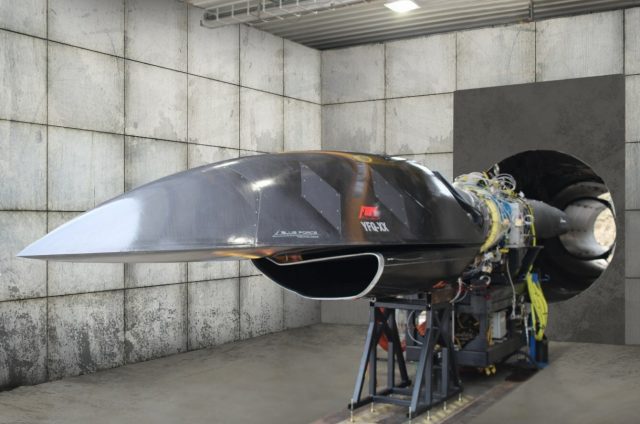Blue Force Technologies (BFT), a start up developing the US Air Force’s new unmanned adversary air aircraft, announced it has successfully completed a ground test for a novel carbon fiber composite propulsion flowpath system.
The test on BFT’s Fury, as the unmanned fighter is also named, was completed in cooperation with the Air Force Research Laboratory (AFRL) as part of the Bandit program.
Under the Bandit program, Blue Force Technologies, a small aerospace and defense company based in North Carolina, will mature a high-performance unmanned air vehicle design that pilots of Air Force fighter aircraft can use to train against.
BFT earlier said it is maturing a high-performance unmanned 5th-generation fighter design that provides replication of pacing threats. The air vehicle technology developed under Bandit supports unmanned adversary air training objectives relevant to the Air Force, Navy and Marine Corps and can be adapted for other Autonomous Collaborative Platform (ACP) mission areas.
Leading into testing, the BFT and AFRL team performed time-accurate computational fluid dynamics (CFD) analysis which leveraged the extensive computational resources of AFRL and Army Engineer Research and Development Center. The purpose of the test was to validate the analysis to gain confidence by the team in using the CFD tool in other portions of the flight envelope. “With AFRL’s help, we are further building out our digital engineering toolchain to enable future ACP variants to be designed quickly,” said Bledsoe.
“The Bandit program is about demonstrating ever tighter model-to-hardware prototype development cycles for autonomous collaborative platforms, and this integrated propulsion flowpath test is indicative of that approach. After making the engine selection in June 2022, the AFRL and Blue Force Technologies team worked to finalize test objectives and procedures concurrently with Blue Force’s hardware build to ensure this full-scale test came together in under six months,” said Alyson Turri, AFRL Bandit program manager.
AFRL, in collaboration with BFT, is exploring the value of digital engineering to expedite ground and flight test by harnessing the artifacts generated through digital analysis as proof of capability. This ground test provided high-fidelity data that will be used in validation of computational methods over the coming months.
“On an uncrewed fighter like Fury, proper integration of the propulsion flowpath is the most significant design driver for the overall vehicle. It was crucial to us to demonstrate, prior to building flight test aircraft, that we could correctly predict the interaction between the propulsion flowpath components and the Williams International engine,” said Scott Bledsoe, president of Blue Force Technologies.



























